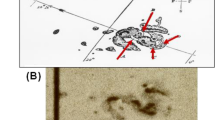Abstract
In the 1980s–1990s possible climatic consequences of the nuclear war were assessed in the papers by academician G.S. Golitsyn and other scientists. The assessment was based on the data of modeling of radiation and circulation processes in the atmosphere under different scenarios of ground-based and air nuclear exchange. Perhaps, underground nuclear explosions do not result in considerable climate effects associated with the emission of the large amount of aerosol to the atmosphere. However, they may cause changes in the rock structure at the big depth, in the composition of underground water as well as of liquid and gas hydrocarbons; the migration of radioactive products from the explosion melt cavity to the water and hydrocarbon layers. The incompleteness of nuclear reactions and heat emission in the melt cavity can be indirectly judged by the results of a thermal survey of the Earth surface in the epicentral zone of the explosion. It is demonstrated that a thermal anomaly is formed here, the temperature exceeds the background temperature of the Earth surface by 8–10°C. The possibility of the space monitoring of thermal anomalies using low-orbiting satellites is considered. It is shown that at cloudless weather for the typical size and temperature of thermal anomalies the flux density is about 9 × 10−10−2 × 10−9 W/cm2 at the space vehicle orbit in the spectral band of 8–14 μm; so, these objects can be registered.
Similar content being viewed by others
References
P. N. Bakharev, N. N. Kiryukhina, and Yu. S. Shakhidzhanov, “Underground Nuclear Explosions as a Source of Radioactive Pollution of the Earth,” Ekologicheskii Zhurnal "Bar'er Bezopasnosti," No. 11-12 (2002) [in Russian].
M. I. Budyko, G. S. Golitsyn, and Yu. A. Izrael, Global Climatic Disasters (Gidrometeoizdat, Leningrad, 1986) [in Russian].
V. P. Busygin and A. I. Andreev, “Local Thermal Anomalies in Epicentral Zones of UNEs in Wells,” Vestnik NYaTs Respubliki Kazakhstan, No. 3 (2004) [in Russian].
V. P. Busygin, A. I. Andreev, and S. A. Kosolapov, “Thermal Regime of Daytime Surface in Epicentral Zone of Underground Nuclear Explosion,” Izv. Akad. Nauk, Fizika Zemli, No. 11 (1999) [in Russian].
A. S. Ginzburg, The Earth in "Post-nuclear" Epoch (Nauka, Moscow, 1988) [in Russian].
A. S. Ginzburg, D. P. Gubanova, and V. M. Minashkin, “Influence of Natural and Anthropogenic Aerosols on Global and Regional Climate,” Rossiiskii Khimicheskii Zhurnal, No. 5, 52 (2008) [Russ. J. General Chem., No. 9, 79 (2009)].
G. S. Golitsyn and A. S. Ginzburg, Climatic Consequences of Possible Nuclear Conflict and Some Natural Analogs (IFA RAN SSSR, Moscow, 1983) [in Russian].
B. N. Golubov, Yu. A. Sapozhnikov, and A. V. Goral'chuk, “Radioactive Pollution of Drainage Water in Udachnyi Diamond Mining Quarry with Kristal Underground Nuclear Explosion Products,” in Geophysical Processes in Lower and Upper Earth Shells, Book 2 (IDG RAN, Moscow, 2003) [in Russian].
G. Gaussorgues, La Thermographie Infrarouge: Principes, Technologie, Applications (Mir, Moscow, 1988) [Transl. from French].
I. G. Granberg, V. P. Busygin, M. A. Iordanskii, et al., "Residual Thermal and Radiation Effects in the Slabbing Zone of Underground Nuclear Explosion (Kalmykia),” in Proceedings of International Symposium "Detection and Monitoring of Underground Nuclear Explosions and Earthquakes,” November 17-21, 1997 (NIIIT, Moscow) [in Russian].
SIPRI Yearbook 2012 (IMEMO RAN, Moscow, 2013) [in Russian].
Yu. A. Izrael, Peaceful Nuclear Explosions and Environment (Gidrometeoizdat, Leningrad, 1974) [in Russian].
Yu. A. Izrael, V. N. Petrov, A. Ya. Pressman, et al., Radioactive Pollution of Natural Environments Caused by Underground Nuclear Explosions and Methods of Its Prediction (Gidrometeoizdat, Leningrad, 1970) [in Russian].
N. Kiryukhina and Yu. Shakhidzhanov, “Eastern Eutope May Lose Potable Water,” Ekologicheskii Zhurnal "Bar'er Bezopasnosti," No. 6-7 (2003) [in Russian].
S. A. Kozhukhov and Yu. V. Kukushkin, “Studying the Migration of Buried Radioactive Products of Kristal Nuclear Explosion,” in Geophysical Processes in Lower and Upper Earth Shells, Book 2 (IDG RAN, Moscow, 2003) [in Russian].
T. Cochran, W. Arkin, R. Norris, and J. Sands, Soviet Nuclear Weapons (AT, Moscow, 1992) [Transl. from English].
Peaceful Nuclear Explosions: Provision of General and Radiation Safety, Ed. by V. A. Logachev (AT, Moscow, 2001) [in Russian].
A. B. Pittock, T. P. Ackerman, P. J. Crutzen, et al., Environmental Consequences of Nuclear War, Vol. 1: Physical and Atmospheric Effects (Mir, Moscow, 1988) [Transl. from English].
Nuclear Explosion Physics, Vol. 1: Explosion Development (Fizmatlit, Moscow, 2009) [in Russian].
M. A. Harwell and T. C. Hutchinson, Environmental Consequences of Nuclear War, Vol. II: Ecological and Agricultural Effects (Mir, Moscow, 1988) [Transl. from English].
Nuclear Tests in the USSR, Ed. by V. N. Mikhailov (IPK VNIIEF, Sarov, 1992) [in Russian].
V. P. Busygin, “Former Underground Nuclear Explosions Sites Remote Monitoring Methods,” in Radioactive Waste Management and Contaminated Site Clean-up. Processes, Technologies and International Experience (Woodhead Publishing Series in Energy, 2013).
A. S. Ginzburg, “Climatic and Atmospheric Concequences of Nuclear War,” Ambio, No. 7, 18 (1989).
A. S. Ginzburg and G. S. Golitsyn, “Comparative Estimates of Climatic Consequences of Martian Dust Storms and a Possible Nuclear War,” Tellus B, No. 3, 37 (1985).
R. A. Mc’Clatchey, R. W. Fenn, J. E. A. Sebli, et al., Optical Properties of the Atmosphere (Revised), Report AFCRL-1971-0279 (1971).
R. Turco, O. Toon, T. Akkerman, et al., “Nuclear Winter: Global Consequences of Multiple Nuclear Explosions,” Science, 222 (1983).
Author information
Authors and Affiliations
Corresponding author
Additional information
Original Russian Text © V.P. Busygin, A.S. Ginzburg, 2016, published in Meteorologiya i Gidrologiya, 2016, No. 2, pp. 55-66.
About this article
Cite this article
Busygin, V.P., Ginzburg, A.S. Atmospheric and Hydrogeological Effects of Underground Nuclear Explosions: Theory, Experiment, and Monitoring. Russ. Meteorol. Hydrol. 41, 112–120 (2016). https://doi.org/10.3103/S1068373916020059
Received:
Published:
Issue Date:
DOI: https://doi.org/10.3103/S1068373916020059




